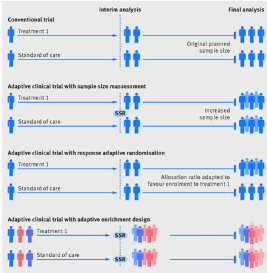18.4. clinical trials phases and design
1/13
There's no tags or description
Looks like no tags are added yet.
Name | Mastery | Learn | Test | Matching | Spaced |
|---|
No study sessions yet.
14 Terms
give features of phase 1-4 clinical trials including their randomisation, their number of people and aim of trial
phase 1:
20-50 people
not randomisaed
finding best dose of treatment, side effects and what happens to the treatment in body
phase 2:
>100
sometimes randomised
Explore efficacy, confirm dose, monitor more side effects,
phase 3:
100s/1000s of people
usually randomised
Compare new treatment with standard/dummy drug
phase 4:
variable
not randomised
long-term benefits and side effects
What is translational research?
Research that translates laboratory discoveries into clinical applications, such as new diagnostic tools, treatments, or technologies.
4 examples of translational research
mapping breast cancer at cellular level
improving targeting biopsies
developing highly sensitive blood tests to track cancer
identifying comprehensive breast cancer risk effects
What is a Randomised Controlled Trial (RCT)
A study where participants are randomly allocated to different groups to compare interventions. It reduces:
Bias (selection, observer)
Confounding - external influences affecting outcomes
Random chance - statistical randomness
What 5 features make a well-designed RCT?
selection of trial participants → eligibility, cohort size
effective allocation of intervention → blinded
Identical treatment protocols across groups (except for intervention)
Robust randomisation and blinding
analysis designed to answer the research question → not to just find statistically different results
What are the 8 key elements of a trial protocol?
Background → why is this study needed?
rationale, objectives → primary & secondary endpoints?
Trial design, setting, treatments → randomised, controlled, observational etc.
Eligibility criteria
trial procedures → treatment plans, follow ups
Data collection, safety monitoring → statistics, quality control
Regulatory and ethical considerations → informed consent
Dissemination plans → publication, sharing of results
what are common inclusion and exclusion criteria?
inclusion:
Age 18+, appropriate disease status
Adequate general health (e.g., performance status 0–2)
No contraindicated medications
Ability to give consent
Exclusion:
Other serious illnesses or conditions
Prior use of similar trial drugs
Pregnancy risk not managed
What is valid informed consent?
Participants must receive adequate, understandable information about the trial before participation, including risks, procedures, and their rights.
Consent must be voluntary and documented.
What are 3 methods of randomisation?
comparable population → demographics and clinically)
large trials → Coin toss, computer-generated randomisation
smaller trial → Block randomisation or stratification (balances demographics like age, severity)
What are 4 challenges and considerations in blinding?
surgical trials
methods of administration may be different
make trial less attractive to participants
expensive to manufacture a placebo
What is safety reporting in clinical trials?
ICP GHP principles provide sponosors & investigators responsibilities regarding safety reporting
cancer trials use CTCAE grading for side effects
serious adverse effects must be reported within 24hrs
What quality control systems are used in trials
systems to maintain participant confidentiality
central & on-site monitoring
accreditation of hospital labs, processing blood samples
manuals for imaging, processing trial blood or tissue samples
established guidelines for determinign results e.g. histopathhology techniques
What are key changes in modern clinical trial design?
More complex protocols (e.g., umbrella/basket trials)
Increased use of AI and wearables
Reduced paper and more digital data
Emphasis on personalised medicine
Flexibility through Bayesian/adaptive designs
What is an adaptive trial design?
A flexible study design that allows for pre-planned modifications based on interim data. It can:
Adjust sample sizes
Combine Phase II/III trials
Add new treatments
Change target populations
Requires statistical simulation and robust analysis planning.
